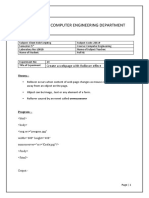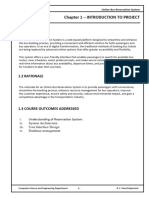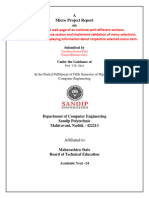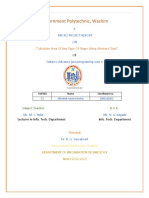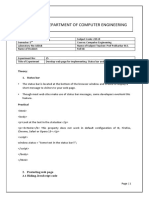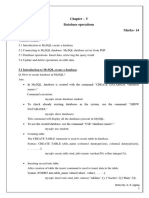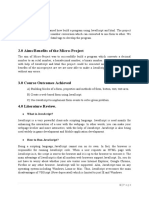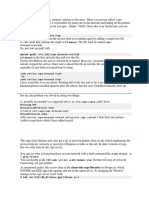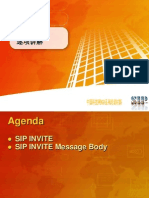Servlets
Softsmith Infotech
�Servers
A server is a computer that responds to requests from a client
Typical requests: provide a web page, upload or download a file,
send email
A server is also the software that responds to these requests; a
client could be the browser or other software making these requests
Typically, your little computer is the client, and someone elses big
computer is the server
However, any computer can be a server
It is not unusual to have server software and client software
running on the same computer
Softsmith Infotech
�Apache
Apache is a very popular server
66% of the web sites on the Internet use Apache
Apache is:
Full-featured and extensible
Efficient
Robust
Secure (at least, more secure than other servers)
Up to date with current standards
Open source
Free
Why use anything else?
Softsmith Infotech
�Ports
A port is a connection between a server and a client
Ports are identified by positive integers
A port is a software notion, not a hardware notion, so there may
be very many of them
A service is associated with a specific port
Typical port numbers:
21FTP, File Transfer Protocol
22SSH, Secure Shell
25SMTP, Simple Mail Transfer Protocol
53DNS, Domain Name Service
80HTTP, Hypertext Transfer Protocol
8080HTTP (used for testing HTTP) These are the ports
of most interest to us
7648, 7649CU-SeeMe
27960Quake III
Softsmith Infotech
�Ports II
My Web page is:
http://www.softsmith.com/~servlet
But it is also:
http:// www.softsmith.com:80 /~servlet
The http: at the beginning signifies a particular protocol
(communication language), the Hypertext Transfer Protocol
The :80 specifies a port
By default, the Web server listens to port 80
The Web server could listen to any port it chose
This could lead to problems if the port was in use by some other
server
For testing servlets, we typically have the server listen to port 8080
In the second URL above, I explicitly sent my request to port 80
If I had sent it to some other port, say, 99, my request would either
go unheard, or would (probably) not be understood
Softsmith Infotech
�CGI Scripts
CGI stands for Common Gateway Interface
Client sends a request to server
Server starts a CGI script
client
Script computes a result for server
and quits
client
Server returns response to client
server
script
Another client sends a request
Server starts the CGI script again
Etc.
Softsmith Infotech
�Servlets
A servlet is like an applet, but on the server side
Client sends a request to server
Server starts a servlet
client
Servlet computes a result for
server and does not quit
client
Server returns response to client
server
servlet
Another client sends a request
Server calls the servlet again
Etc.
Softsmith Infotech
�Servlets vs. CGI scripts
Advantages:
Running a servlet doesnt require creating a separate process
each time
A servlet stays in memory, so it doesnt have to be reloaded
each time
There is only one instance handling multiple requests, not a
separate instance for every request
Untrusted servlets can be run in a sandbox
Disadvantage:
Less choice of languages (CGI scripts can be in any language)
Softsmith Infotech
�Servlets
A servlet is any class that implements the javax.servlet.Servlet
interface
In practice, most servlets extend the
javax.servlet.http.HttpServlet class
Some servlets extend javax.servlet.GenericServlet instead
Servlets, like applets, usually lack a main method, but must
implement or override certain other methods
Softsmith Infotech
�Important servlet methods, I
When a servlet is first started up, its init(ServletConfig config)
method is called
init should perform any necessary initializations
init is called only once, and does not need to be thread-safe
Every servlet request results in a call to
service(ServletRequest request, ServletResponse response)
service calls another method depending on the type of service
requested
Usually you would override the called methods of interest, not
service itself
service handles multiple simultaneous requests, so it and the
methods it calls must be thread safe
When the servlet is shut down, destroy() is called
destroy is called only once, but must be thread safe (because
other threads may still be running)
Softsmith Infotech
10
�HTTP requests
When a request is submitted from a Web page, it is almost always a
GET or a POST request
The HTTP <form> tag has an attribute action, whose value can be
"get" or "post"
The "get" action results in the form information being put after a ? in
the URL
Example:
http://www.google.com/search?hl=en&ie=UTF-8&oe=UTF8&q=servlets
The & separates the various parameters
Only a limited amount of information can be sent this way
"put" can send large amounts of information
Softsmith Infotech
11
�Important servlet methods, II
The service method dispatches the following kinds of requests:
DELETE, GET, HEAD, OPTIONS, POST, PUT, and TRACE
A GET request is dispatched to the doGet(HttpServletRequest
request, HttpServletResponse response) method
A POST request is dispatched to the doPost(HttpServletRequest
request, HttpServletResponse response) method
These are the two methods you will usually override
doGet and doPost typically do the same thing, so usually you do
the real work in one, and have the other just call it
public void doGet(HttpServletRequest request,
HttpServletResponse response) {
doPost(request, response);
}
Softsmith Infotech
12
�A Hello World servlet
(from the Tomcat installation documentation)
public class HelloServlet extends HttpServlet {
public void doGet(HttpServletRequest request,
HttpServletResponse response)
throws ServletException, IOException {
response.setContentType("text/html");
PrintWriter out = response.getWriter();
String docType =
"<!DOCTYPE HTML PUBLIC \"-//W3C//DTD HTML 4.0 " +
"Transitional//EN\">\n";
out.println(docType +
"<HTML>\n" +
"<HEAD><TITLE>Hello</TITLE></HEAD>\n" +
"<BODY BGCOLOR=\"#FDF5E6\">\n" +
"<H1>Hello World</H1>\n" +
"</BODY></HTML>");
}
}
Dont worry,
well take
this a little at a time!
Softsmith
Infotech
13
�The superclass
public class HelloServlet extends HttpServlet {
Every class must extend GenericServlet or a subclass of
GenericServlet
GenericServlet is protocol independent, so you could write
a servlet to process any protocol
In practice, you almost always want to respond to an HTTP
request, so you extend HttpServlet
A subclass of HttpServlet must override at least one method,
usually one doGet, doPost, doPut, doDelete, init and destroy, or
getServletInfo
Softsmith Infotech
14
�The doGet method
public void doGet(HttpServletRequest request,
HttpServletResponse response)
throws ServletException, IOException {
This method services a GET request
The method uses request to get the information that was sent to it
The method does not return a value; instead, it uses response to get
an I/O stream, and outputs its response
Since the method does I/O, it can throw an IOException
Any other type of exception should be encapsulated as a
ServletException
The doPost method works exactly the same way
Softsmith Infotech
15
�Parameters to doGet
Input is from the HttpServletRequest parameter
Our first example doesnt get any input, so well discuss this a bit
later
Output is via the HttpServletResponse object, which we have named
response
I/O in Java is very flexible but also quite complex, so this object
acts as an assistant
Softsmith Infotech
16
�Using the HttpServletResponse
The second parameter to doGet (or doPost) is HttpServletResponse
response
Everything sent via the Web has a MIME type
The first thing we must do with response is set the MIME type of our
reply: response.setContentType("text/html");
This tells the client to interpret the page as HTML
Because we will be outputting character data, we need a
PrintWriter, handily provided for us by the getWriter method of
response:
PrintWriter out = response.getWriter();
Now were ready to create the actual page to be returned
Softsmith Infotech
17
�Using the PrintWriter
From here on, its just a matter of using our PrintWriter, named
out, to produce the Web page
First we create a header string:
String docType =
"<!DOCTYPE HTML PUBLIC \"-//W3C//DTD HTML 4.0 " +
"Transitional//EN\">\n";
This line is technically required by the HTML spec
Browsers mostly dont care, but HTML validators do care
Then use the println method of out one or more times
out.println(docType +
"<HTML>\n" +
"<HEAD> ... </BODY></HTML>");
And were done!
Softsmith Infotech
18
�Input to a servlet
A GET request supplies parameters in the form
URL ? name=value & name=value & name=value
(Illegal spaces added to make it more legible)
Actual spaces in the parameter values are encoded by + signs
Other special characters are encoded in hex; for example, an
ampersand is represented by %26
Parameter names can occur more than once, with different values
A POST request supplies parameters in the same syntax, only it is in
the body section of the request and is therefore harder for the user
to see
Softsmith Infotech
19
�Getting the parameters
Input parameters are retrieved via messages to the
HttpServletRequest object request
Most of the interesting methods are inherited from the
superinterface ServletRequest
public Enumeration getParameterNames()
Returns an Enumeration of the parameter names
If no parameters, returns an empty Enumeration
public String getParameter(String name)
Returns the value of the parameter name as a String
If the parameter doesnt exist, returns null
If name has multiple values, only the first is returned
public String[] getParameterValues(name)
Returns an array of values of the parameter name
If the parameter doesnt exist, returns null
Softsmith Infotech
20
�Enumeration review
An Enumeration is almost the same as Iterator
Its an older class, and the names are longer
Example use:
Enumeration e = myVector.elements();
while (e.hasMoreElements()) {
System.out.println(e.nextElement());
}
Softsmith Infotech
21
�Example of input parameters
public void doGet(HttpServletRequest request,
HttpServletResponse response) {
... stuff omitted ...
out.println("<H1>Hello");
String names[] =
request.getParameterValues("name");
if (names != null)
for (int i = 0; i < names.length; i++)
out.println(" " + names[i]);
out.println("!");
}
Softsmith Infotech
22
�Java review: Data from Strings
All parameter values are retrieved as Strings
Frequently these Strings represent numbers, and you want the
numeric value
int n = new Integer(param).intValue();
double d = new Double(param).doubleValue();
byte b = new Byte(param).byteValue();
Similarly for short, float, and long
These can all throw a NumberFormatException, which is
a subclass of RuntimeException
boolean p = new Boolean(param).booleanValue();
But:
char c = param.charAt(0);
Softsmith Infotech
23
�Session Tracking
What is Session?
A Session refers to all the request that a single client makes to a
server.
Every user has a separate session and separate session variable is
associated with that session.
A session is specific to the user and for each user a new session is
created to track all the request from that user.
Softsmith Infotech
24
�Session Tracking Mechanism
"Session Tracking" is a mechanism which helps the servers to
maintain the state to track the series of requests from the same user
across some period of time.
Softsmith Infotech
25
�Mechanism for Session Tracking
HttpSession.
Cookies.
URL rewriting .
Hidden form fields.
Softsmith Infotech
26













